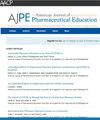Unlocking Findings of Entrustable Professional Activities for Trainee Development, Entrustment, and Practice Readiness in Pre-registration Pharmacy Training: A Systematic Review
IF 3.5
4区 教育学
Q1 EDUCATION, SCIENTIFIC DISCIPLINES
引用次数: 0
Abstract
Objective
To explore key findings on the use of entrustable professional activities (EPAs) in preregistration pharmacy training, with a focus on their role in trainee development, entrustment decision-making, and practice readiness.
Methods
A systematic search was conducted across 5 electronic databases (MEDLINE, Embase, Scopus, Emcare, and Cumulative Index to Nursing and Allied Health Literature (CINAHL)) to identify studies reporting on the use of EPAs in preregistration pharmacy training. Studies that described how EPAs influenced trainee development, entrustment decision-making, and practice readiness were included. Two independent reviewers screened and extracted data from the included studies. Key findings were synthesized into thematic domains. The Mixed Methods Appraisal Tool 2018 was used to evaluate the quality of the included studies.
Results
A total of 581 articles were screened, with 27 meeting the inclusion criteria (17 quantitative descriptive, 7 mixed methods, and 3 qualitative studies). A narrative synthesis of the eligible studies revealed 3 key findings: EPAs support the progressive entrustment of trainees across different time points in training, EPA implementation enhances trainees’ self-directed learning and self-awareness skills, and supervisor entrustment decisions are influenced by a range of contextual, personal, and trainee-related factors. Although EPAs were consistently associated with increased trainee autonomy, entrustment practices among supervisors remained relatively variable. Most included studies were assessed as medium to high quality.
Conclusion
The use of EPAs in pharmacy education fosters trainee autonomy, self-assessment, and professional growth in trainees. However, variability in supervisor decision-making highlights the need for further research to support consistent EPA implementation and supervisor training in authentic practice environments.
解锁可委托的专业活动的发现,学员发展,委托,并在注册前药房培训实践准备-系统回顾。
目的:探讨委托专业活动(EPAs)在注册前药学培训中使用的主要发现,重点关注其在学员发展、委托决策和执业准备方面的作用。方法:通过5个电子数据库(MEDLINE、Embase、CINAHL、Scopus和Emcare)进行系统检索,以确定在注册前药学培训中使用EPAs的研究报告。研究描述了如何EPAs影响学员发展,委托决策,和实践准备。两名独立的审稿人从纳入的研究中筛选和提取数据。主要调查结果被综合到专题领域。使用混合方法评估工具2018来评估纳入研究的质量。结果:共筛选581篇文献,其中27篇符合纳入标准(17篇定量描述性研究,7篇混合方法研究,3篇定性研究)。对合格研究的叙述综合揭示了三个关键发现:1。EPAs支持学员在培训的不同时间点的逐步委托,2。EPA的实施提高了学员的自主学习和自我意识技能;主管的委托决策受到一系列环境因素、个人因素和培训生相关因素的影响。虽然EPAs一直与受训人员自主性的增加有关,但主管之间的委托实践仍然相对可变。大多数纳入的研究被评估为中等到高质量。结论:EPAs在药学教育中的应用促进了学员的自主性、自我评价和专业成长。然而,监管决策的可变性突出了进一步研究的必要性,以支持在真实实践环境中一致的EPA实施和监管培训。
本文章由计算机程序翻译,如有差异,请以英文原文为准。
求助全文
约1分钟内获得全文
求助全文
来源期刊
CiteScore
4.30
自引率
15.20%
发文量
114
期刊介绍:
The Journal accepts unsolicited manuscripts that have not been published and are not under consideration for publication elsewhere. The Journal only considers material related to pharmaceutical education for publication. Authors must prepare manuscripts to conform to the Journal style (Author Instructions). All manuscripts are subject to peer review and approval by the editor prior to acceptance for publication. Reviewers are assigned by the editor with the advice of the editorial board as needed. Manuscripts are submitted and processed online (Submit a Manuscript) using Editorial Manager, an online manuscript tracking system that facilitates communication between the editorial office, editor, associate editors, reviewers, and authors.
After a manuscript is accepted, it is scheduled for publication in an upcoming issue of the Journal. All manuscripts are formatted and copyedited, and returned to the author for review and approval of the changes. Approximately 2 weeks prior to publication, the author receives an electronic proof of the article for final review and approval. Authors are not assessed page charges for publication.

 求助内容:
求助内容: 应助结果提醒方式:
应助结果提醒方式:


